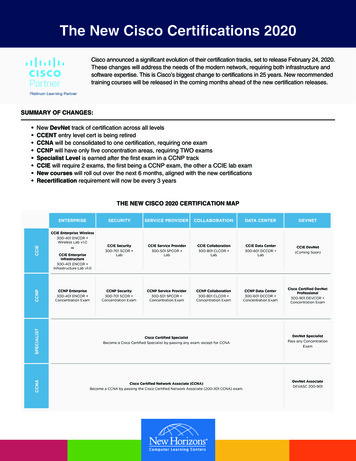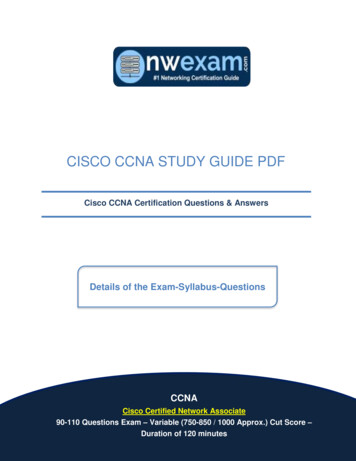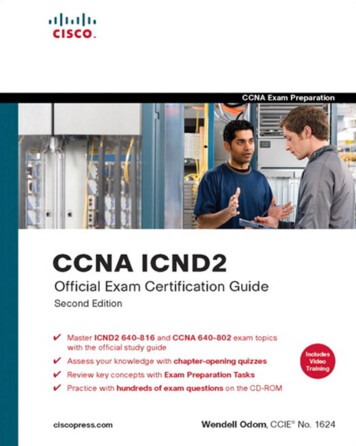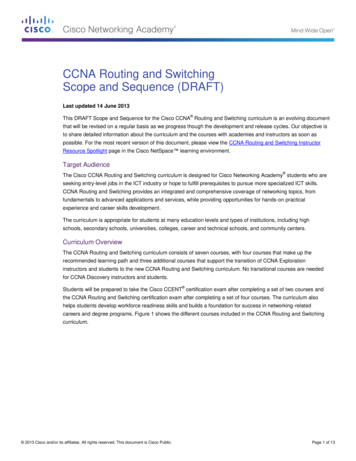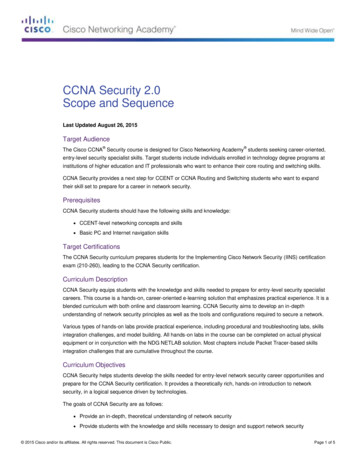
Transcription
CCNA Security 2.0Scope and SequenceLast Updated August 26, 2015Target Audience The Cisco CCNA Security course is designed for Cisco Networking Academy students seeking career-oriented,entry-level security specialist skills. Target students include individuals enrolled in technology degree programs atinstitutions of higher education and IT professionals who want to enhance their core routing and switching skills.CCNA Security provides a next step for CCENT or CCNA Routing and Switching students who want to expandtheir skill set to prepare for a career in network security.PrerequisitesCCNA Security students should have the following skills and knowledge: CCENT-level networking concepts and skills Basic PC and Internet navigation skillsTarget CertificationsThe CCNA Security curriculum prepares students for the Implementing Cisco Network Security (IINS) certificationexam (210-260), leading to the CCNA Security certification.Curriculum DescriptionCCNA Security equips students with the knowledge and skills needed to prepare for entry-level security specialistcareers. This course is a hands-on, career-oriented e-learning solution that emphasizes practical experience. It is ablended curriculum with both online and classroom learning. CCNA Security aims to develop an in-depthunderstanding of network security principles as well as the tools and configurations required to secure a network.Various types of hands-on labs provide practical experience, including procedural and troubleshooting labs, skillsintegration challenges, and model building. All hands-on labs in the course can be completed on actual physicalequipment or in conjunction with the NDG NETLAB solution. Most chapters include Packet Tracer-based skillsintegration challenges that are cumulative throughout the course.Curriculum ObjectivesCCNA Security helps students develop the skills needed for entry-level network security career opportunities andprepare for the CCNA Security certification. It provides a theoretically rich, hands-on introduction to networksecurity, in a logical sequence driven by technologies.The goals of CCNA Security are as follows: Provide an in-depth, theoretical understanding of network security Provide students with the knowledge and skills necessary to design and support network security 2015 Cisco and/or its affiliates. All rights reserved. This document is Cisco Public.Page 1 of 5
Provide an experience-oriented course that employs industry-relevant instructional approaches to preparestudents for entry-level jobs in the industry Enable students to have significant hands-on interaction with IT equipment to prepare them for certificationexams and career opportunitiesUpon completion of the CCNA Security course, students will be able to perform the following tasks: Explain network threats, mitigation techniques, and the basics of securing a network Secure administrative access on Cisco routers Secure administrative access with AAA Implement firewall technologies to secure the network perimeter Configure IPS to mitigate attacks on the network Describe LAN security considerations and implement endpoint and Layer 2 security features Describe methods for implementing data confidentiality and integrity Implement secure virtual private networks Implement an ASA firewall configuration using the CLI Implement an ASA firewall configuration and VPNs using ASDM Test network security and create a technical security policyMinimum System RequirementsCCNA Security curriculum requirements: 1 Student PC per studentLab bundle requirements for CCNA Security:Detailed equipment information, including descriptions and part numbers, is available on Cisco Netspace on theEquipment Information page. Please refer to that document for the latest information, which includes specificationsfor the following minimum equipment required: 3 Cisco routers, 2 with the Security Technology Package License 3 Two-Port Serial WAN Interface Cards 3 Cisco switches 1 Cisco Adaptive Security Appliance (ASA) Assorted Ethernet and Serial cables and hubs 2015 Cisco and/or its affiliates. All rights reserved. This document is Cisco Public.Page 2 of 5
The equipment should be set up in the following configuration: 2015 Cisco and/or its affiliates. All rights reserved. This document is Cisco Public.Page 3 of 5
CCNA Security OutlineThis course teaches students the skills needed to obtain entry-level security specialist jobs. It provides a hands-onintroduction to network security. Instructors are encouraged to provide outside-the-classroom learning experiences.Chapter OutlineTable 1.Chapter OutlineChapter /SectionGoals/ObjectivesChapter 1. Modern Network Security ThreatsExplain network threats, mitigation techniques, and the basics of securing a network1.1Securing NetworksExplain network security1.2Network ThreatsDescribe various types of threats and attacks1.3Mitigating ThreatsExplain tools and procedures to mitigate the effects of malware and common network attacks.Chapter 2. Securing Network DevicesSecure administrative access on Cisco routers2.1Securing Device AccessConfigure secure administrative access2.2Assigning Administrative RolesConfigure command authorization using privilege levels and role-based CLI2.3Monitoring and Managing DevicesImplement the secure management and monitoring of network devices.2.4Using Automated Security FeaturesUse automated features to enable security on IOS-based routers.Chapter 3. Authentication, Authorization andSecure administrative access with AAAAccounting3.1Purpose of AAAExplain how AAA is used to secure a network.3.2Local AAA AuthenticationImplement AAA authentication that validates users against a local database.3.3Server-Based AAAExplain server-based AAA authentication and its communication protocols.3.4Server-Based AAA AuthenticationImplement server-based AAA authentication using TACACS and RADIUS protocols.Server-Based AAA Authorization andConfigure server-based AAA authorization and accounting3.5AccountingChapter 4. Implementing Firewall TechnologiesImplement firewall technologies to secure the network perimeter4.1Access Control ListsImplement access control lists (ACLs) to filter traffic and mitigate network attacks on a network.4.2Firewall TechnologiesConfigure a classic firewall to mitigate network attacks.4.3Zone-Based Policy FirewallsImplement Zone-Based Policy Firewall using CLI.Chapter 5. Implementing Intrusion PreventionConfigure IPS to mitigate attacks on the network5.1IPS TechnologiesExplain how network-based IPS is used to help secure a network.5.2IPS SignaturesExplain how signatures are used to detect malicious network traffic.5.3Implement IPSConfigure Cisco IOS IPS operations using CLI. 2015 Cisco and/or its affiliates. All rights reserved. This document is Cisco Public.Page 4 of 5
Chapter /SectionGoals/ObjectivesChapter 6. Securing the Local Area NetworkDescribe LAN security considerations and implement endpoint and Layer 2 securityfeatures6.1Endpoint SecurityExplain endpoint vulnerabilities and protection methods.6.2Layer 2 Security ConsiderationsImplement Layer 2 security features.Chapter 7. Cryptographic SystemsDescribe methods for implementing data confidentiality and integrity7.1Cryptographic ServicesExplain how the types of encryption, hashes, and digital signatures work together to provideconfidentiality, integrity, and authentication.7.2Basic Integrity and AuthenticityExplain how cryptographic hashes are used to ensure data integrity and authentication.7.3ConfidentialityExplain how encryption algorithms are used to ensure data confidentiality.7.4Public Key CryptographyExplain how a public key infrastructure is used to ensure data confidentiality and provideauthentication.Chapter 8. Implementing Virtual Private NetworksImplement secure virtual private networks8.1VPNsExplain the purpose of VPNs.8.2IPsec VPN Components and OperationExplain how IPsec VPNs operate.8.3Implementing Site-to-Site IPsec VPNs with CLIConfigure a site-to-site IPsec VPN, with pre-shared key authentication, using CLI.Chapter 9. Implementing the Cisco AdaptiveImplement an ASA firewall configuration using the CLISecurity Appliance9.1Introduction to the ASAExplain how the ASA operates as an advanced stateful firewall.9.2ASA Firewall ConfigurationImplement an ASA firewall configuration.Chapter 10. Advanced Cisco Adaptive SecurityImplement an ASA firewall configuration and VPNs using ASDMAppliance10.1 ASA Security Device ManagerImplement an ASA firewall configuration.10.2 ASA VPN ConfigurationConfigure remote-access VPNs on an ASA.Chapter 11. Managing a Secure NetworkTest network security and create a technical security policy11.1 Network Security TestingExplain the various techniques and tools used for network security testing.11.2 Developing a Comprehensive Security PolicyExplain how to develop a comprehensive security policy. 2015 Cisco and/or its affiliates. All rights reserved. This document is Cisco Public.Page 5 of 5
CCNA Security provides a next step for CCENT or CCNA Routing and Switching students who want to expand their skill set to prepare for a career in network security. Prerequisites CCNA Security students should have the following skills and knowledge: CCENT-level networking concepts and skills Basic PC and Internet navigation skills
